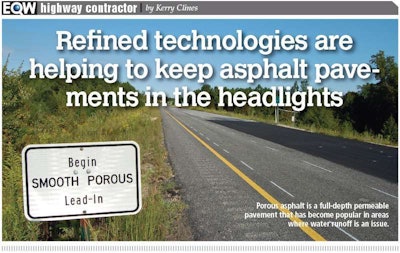
Several asphalt mixes are also reflecting an emphasis on sustainability, including energy-saving warm-mix asphalt (WMA) technologies and recycled materials such as reclaimed asphalt pavement (RAP) and reclaimed asphalt shingles (RAS).
Warm-mix asphalt
Dr. Heather Dylla, director of sustainable engineering at the National Asphalt Pavement Association (NAPA), points to several trends revealed in the association’s annual survey on the use of recycled materials and warm-mix asphalt.
Since being introduced in the United States in 2004, the use of warm-mix asphalt has seen an explosive growth. According to the NAPA survey, warm-mix asphalt usage has increased by 533 percent since 2009. The technologies behind warm-mix asphalt improve the workability of the mix, leading to better performance of the asphalt mixture in the pavement.
“In 2012, approximately 25 percent of the total asphalt tonnage was warm-mix asphalt,” Dylla says, adding that, by the 2013 construction season, 30 percent of total tonnage is warm-mix asphalt. “We are pretty proud of how successful we’ve been at its deployment. The technology came from Europe, but Europe hasn’t been as aggressive in deploying warm-mix technologies as the United States has been.”
When the asphalt doesn’t have to be heated to as high a temperature, less energy is used, which means fewer emissions. Low emissions are important for keeping things “green” on the construction site. Worker comfort is also greatly improved, since they aren’t exposed to high temperatures.
Improvements are still in the works for this successful product. According to Dylla, other technologies are being explored to get the temperatures even lower than they are now.
Reclaimed asphalt pavement
The asphalt paving industry is now recycling at a rate of more than 99 percent, says Dylla, pointing out that the NAPA survey shows only 100,000 tons of RAP made it to landfills. “A majority of RAP is being used in hot-mix and warm-mix asphalt, which means we not only get the value of the aggregate, but we get the value of the binder as well, and that’s a good thing,” she says. “That trend has been increasing, as only 64 million tons were used five years ago.”
On average, departments of transportation (DOTs) use nearly 20 percent RAP in their mixes, which is almost double what it was five years ago when they only allowed approximately 10 percent. Some DOTs use as much as 30 percent now, and these percentages are expected to increase.
Late last year, a group of 11 people made up NAPA representatives, asphalt contractors, state asphalt pavement association representatives, and four state DOT representatives made a trip to Japan to explore how Japan has been able to use 50, 60, and even 70 percent RAP in its asphalt mixes.
Dr. Randy West. P.E., director at the National Center for Asphalt Technology, was on the trip. “I don’t think we’re going to change the [U.S.] industry to make it the way they do things in Japan, but one of the things that is well rooted in Japan, and is only beginning here, is the use of rejuvenators.”
A rejuvenator is an asphalt-like, low-viscosity binding material that interacts with the old binder in the RAP to restore its properties. When Japanese contractors use high-RAP contents in their asphalt mixes, they preheat the RAP then add the rejuvenators to the hot RAP to give the rejuvenator time to interact with the RAP binder before mixing with the virgin asphalt and aggregate.
According to West, rejuvenators have only been used on an experimental scale in the United States. There are a number of companies selling rejuvenators and other materials coming into the market, but most are fairly new. NCAT and other research organizations are evaluating the different rejuvenators to see how well they work. If they prove successful with RAP, they could be used with reclaimed asphalt shingles as well.
An education session at NAPA’s annual convention in January covered the information gathered from the trip to Japan. Anyone who was unable to attend the convention will be able to find information about the trip in a publication that should be available this summer.
NCAT is also working on a RAP project for the Virginia DOT at its test track in Alabama. The project involves doing a bit of stabilization to 100-percent RAP and using it as a base material.
“There are a number of different ways to stabilize it, but Virginia decided on foamed asphalt stabilization,” West says. “For the test track experiments, we ran the RAP through a small portable plant and add about 2 percent of the foamed asphalt along with approximately 1 percent of Portland cement. That material was then hauled to the paving site and placed cold, but paved with conventional paving equipment and rolled with regular rollers. The material behaves a lot like hot-mix asphalt in pavement response, and it is a pretty low-cost material where there is an excess supply of RAP. The test track section is proving that it is a very reliable option where there are excess quantities of RAP, which is common in large metropolitan areas. That’s a trend that is catching on in Virginia.”
Porous asphalt
Porous asphalt is a type of permeable pavement, which is becoming more popular in areas where help is needed with water drainage. Though similar in appearance, porous asphalt should not be confused with open-graded friction course (OGFC). OGFC is often used as a surface layer on highways to help mitigate hydroplaning and improve traction. Porous pavement, on the other hand, goes much deeper than that, literally. It is a full-depth pavement with a water-collection basin as a part of its design.
“Porous asphalt is really growing,” Dylla says. For example, Commercial Street, a main artery in Provincetown, Massachusetts, was paved with porous asphalt. “The porous asphalt helped keep the beaches open during the entire tourist season, where before they would close because of stormwater contamination caused by runoff from the street.”
Thin overlays for pavement preservation
With shrinking DOT budgets and no long-term transportation funding bill in sight, more state and local governments are using pavement preservation techniques in an effort to simply maintain their roads. A number of techniques are being used, including simple crack sealing, chip seals, and micro-surfacing, but the one that seems to be trending the most is thin overlays, or Thinlays.
Thinlays are a pavement rehabilitation technique where a thin layer of asphalt is placed on top of an existing pavement to extend its life and performance. In addition to pavement preservation, they are also used to fix roads considered unsafe or too noisy. They also help preserve a road in a way that allows for a better allocation of resources and budget, Dylla says. Texas, for example, has pioneered thin overlay mixes as thin as 1/2-inch thick.
Perpetual pavement
Since the majority of roadwork these days focuses on maintenance, there aren’t many new roads being built from the ground up. But when a new road is built, NAPA would like to see perpetual pavement designs being used. West admits, however, that while perpetual pavement is a good engineering approach, there’s not much opportunity to build new pavements. “A long-term highway bill might help to some degree,” he says, “and there will always be the need for new capacity and new roadways, but we have a fairly mature highway system in the United States, so the majority of the work now is maintaining the roadways that we already have. We need to keep encouraging highway agencies to consider the long-term value of perpetual pavement design when those projects do come along to build a completely new pavement.”
In perpetual pavement design, the foundation is built so that no damage occurs in lower layers, so only periodic maintenance of the top layer is required. The pavement structure remains intact, and only the top layer is milled and replaced with a Thinlay or other appropriate surfacing. This type of pavement has been designed so well that the surface can go 15 to 20 years between maintenance because there is no stress occurring from the base.
“There are groups trying to promote perpetual pavement as a long-term solution,” Dylla says. “If we are unable to have the kind of budget necessary to maintain every road on a regular basis, we need to be building perpetual roads that don’t require frequent maintenance.”












